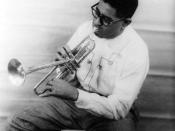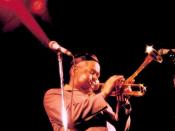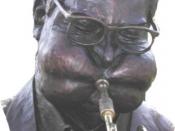Jazz In America
Since its conception, jazz has spread across the world, dominating the music industry with its unique sound and structure. Jazz has not only affected the musical world, but it has also touched all aspects of life, especially in America. Jazz foreshadowed a new way of life for Americans. Jazz of the 1940s and 1950s had a profound impact on the social environment and music of America; analysis of jazz artists' quest for recognition and acceptance, jazz patrons' pursuit of happiness and self-expression, and the use of freedom in jazz confirms the deep influence it had on America. No one foresaw that jazz would change so greatly.
In the 1940s and 1950s, African-Americans were still feeling severe amounts of discrimination. The Cotton Club in Harlem would only allow white people to enjoy what they called "primitive music" (Porter 102). White society did not even consider jazz at that time to be an authentic art form.
Porter states, "[. . .]The club was decorated like a plantation, and some of the skits involved sexually provocative dances performed in 'African' attire (Porter 102). Black people were still viewed as ignorant slaves that were lower than the rest of society. Black musicians seemed to be merely social servants whose sole purpose was to entertain (Catlin). Many black jazz musicians were seeking social and musical acceptance by society. Duke Ellington attempted to raise the level of dignity African-Americans were receiving in a multitude of ways. Ellington was a very proper man who conducted himself perfectly (Jazz). He "stuck out" from the normal crowd of unkempt musicians because of his image. Likewise,
Denny 2
Ellington would require his band to use perfect etiquette and dress themselves to compliment their clean manners (Jazz). Ellington hoped people would recognize his band's image and begin to...


